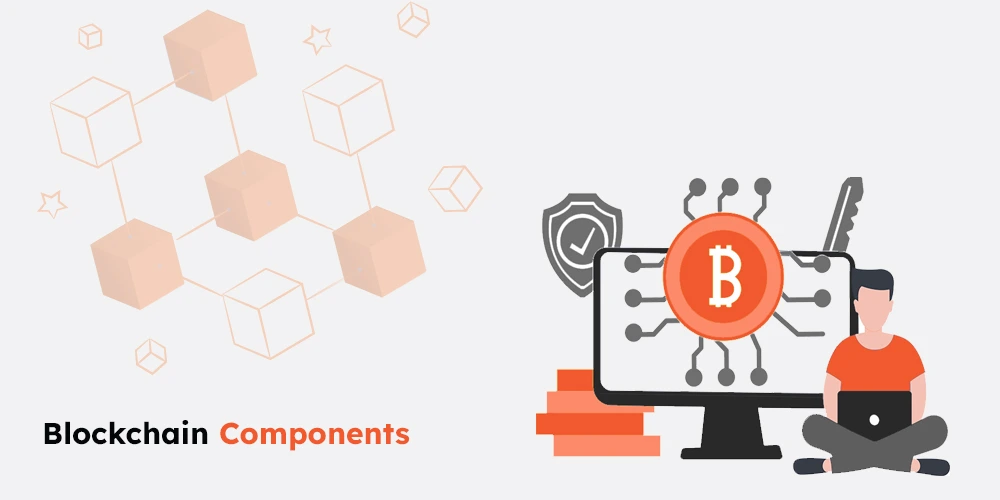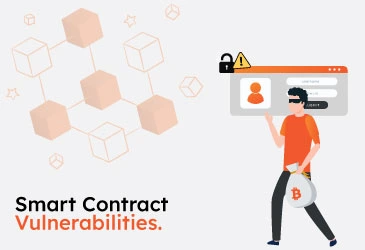Blockchain Components
Updated : June 12, 2023

Blockchain technology has become immensely prominent in recent years, particularly in trustless networks, to guarantee solid data integrity. The blockchain is a decentralized public ledger that functions analogous to a log by maintaining an unaltered record of all transactions and storing them in chronological order.
Blockchain is also used to refer to a platform for decentralized computing and information sharing that enables the collaboration of several authoritative domains in the form of logical decision-making. Blockchain, being different from traditional database models, provides exceptional features which include decentralization, immutability, irreversibility, persistence, and anonymity.
Blockchain's structure is designed to guarantee the confidentiality of information via its consensus mechanism, offering a safe, open, and impenetrable way to trace and verify the transaction process. But to provide a real interpretation that a layman can understand, it is imperative to explore the functionality of Blockchain Components, their features, and basic concepts. And once you are willing to put ideas into practice, discover the capabilities of our Blockchain Development Services.
Core Components in a Blockchain
A blockchain network includes nodes, a distributed ledger, wallet, nonce, hash, an asset, and a consensus algorithm.
Nodes
The blockchain network's structure consists of nodes. Different tasks are assigned to nodes on the network, such as validator and miner. Nodes are gadgets that have computing capability and a node application installed. Every blockchain has a unique node application that contains the information and guidelines needed to function as a node on that network. To maintain network integrity, they validate transactions, monitor the distributed ledger, and take part in consensus methods.
Distributed ledger
Another name for the distributed ledger is the blockchain's database. To offer fault tolerance for the whole network, each node has a copy of the ledger. On the blockchain network, a ledger is unchangeable and accessible to all users. It consists of blocks with assets that are connected consecutively. The hash of the preceding block is used to connect subsequent blocks
Distributed ledgers provide a distributed database that creates a network that links users; nodes are the computers that these users use to connect. Ledgers, which are lists of transactions that are sorted chronologically and timestamped, are among these nodes. These ledgers can only be added to the database, guaranteeing a secure method of tracking transactions without the requirement for a central authority to verify. When blockchain technology entered its second generation, smart contracts replaced the P2P method of initial transaction processing. Transaction protocols known as smart contracts govern how ledgers are sent between nodes. As a result, using the browser as a lightweight middleware is an alternative technology to distributed ledger, however it is still in the testing stage.
Wallet
This is a type of online wallet that lets users store their cryptocurrency. In the blockchain network, a Wallet is present on each node. Using public and private key pairs, a wallet's privacy in a blockchain network is protected. Currency conversion is not necessary while using a wallet because the currency is accepted everywhere.
Nonce
A nonce, often known as a "number only used once," is a number that is added to a block that has been hashed or encrypted in a blockchain. The 32-bit integer that helps to produce a new block or validate a transaction is created randomly just once. It is employed to increase the transaction's security
Finding a number that may be used as a nonce is difficult. A significant degree of trial and error is necessary. A miner first guesses a nonce. The guessed nonce is then added to the current header's hash. The value is then hashed again, and this hash is compared to the target hash. Now it determines whether or not the generated hash value satisfies the specifications. When all the requirements are satisfied, the miner has produced an answer and is given the block
Hash
Using hashing, the data is mapped to a fixed size. It is crucial to the field of cryptography. In a blockchain network, the input for one transaction is its hash value. The following are the hash function's properties:
- Hiding
- Collision resistant
- Puzzle friendliness
Asset
Anything with a value recognised by the network's nodes can be an asset, whether it be something tangible or intangible. The following are some cases of assets:
- Financial transactions: To keep the details of cryptocurrency transactions, blockchains like Bitcoin and Dogecoin employ a ledger.
- Code blocks: Code blocks are the building blocks of the notion of Dapps and are used by blockchains like Ethereum to store code in the form of smart contracts
- Medical records: Medical records are typically stored on private blockchains to preserve integrity in an unreliable setting
- Business transactions: To guarantee the quality of the product and the fulfillment of certain requirements, businesses can utilize private blockchains when carrying out transactions involving other businesses. This increases security and accountability
Consensus algorithm
Blockchain works as a successful substitute for centralized applications thanks to a consensus mechanism. In the context of centralized applications, all users have faith in the central authority to carry out transactions in a trustworthy manner. However, in an absence of a centralized authority, the network's nodes are in charge of executing this role. In a context where trust is lacking, blockchains use consensus techniques like Proof of Work (POW) and Proof of Stake (POS).
Consensus Mechanism:
When nodes start exchanging data over a blockchain platform, they lack a central authority to oversee and arbitrate disputes or protect against security breaches. As a result, a consensus mechanism is required to monitor money flows and guarantee an impenetrable exchange to prevent fraud like double spending attacks. To keep this ledger in a consistent form, all nodes should agree on a standard procedure for updating the content, and blocks shouldn't just be automatically accepted into the blockchain without majority approval. This is called a consensus mechanism, by which blocks are constructed and added to the current ledger for use in future.
To reach consensus, the validator nodes receive the transaction that the miner made using the consensus procedure. If an agreement is obtained, the transaction is either accepted and recorded in the ledger or it is rejected.
Occasionally a virtual machine and a state database are also included in Blockchain Components.
Virtual machine
Blockchains like Ethereum run virtual machines on their nodes. They are used to execute code written in smart contracts. This is done to ensure that if the code being executed on the nodes contains malware, it will not affect the node executing the code. Instead, it will just affect the virtual machine running on top of the physical hardware saving the node.
State Database
The network's present state is reflected in this key-value database. Traversing the ledger is used to calculate it. It is used to speed up transactions because updating the network's state for every transaction would take too long and would slow down the network's overall performance.
Understanding blockchain components is essential for recognising the technology's transformational potential. Each element helps to build a safe, open, and impenetrable digital ledger that has the potential to reinvent industries and trust in the digital era. Understanding these foundational components will enable us to fully utilize blockchain technology.
Take control of your smart contract security - Request a professional Smart Contract Audit today and ensure the solidity of your blockchain projects
Insights

Smart Contract Audit Checklist
Smart contracts are self-executing agreements with the terms of the agreement between buyer and seller being directly written into lines of code ...

How To Audit Smart Contracts?
Smart contracts have become increasingly popular over the years as they provide a more efficient way of executing transactions in a decentralized ...

Smart Contract Vulnerabilities
Smart contracts have revolutionized how we conduct transactions and execute agreements in the digital age. These self-executing programs ...